Anchor Rode Components
Swivel
Swivels are used to connect the anchor to the chain. In contrast to a simple shackel, swivels
have the ability to rotate so that the orientation of the anchor while setting is not hindered by a
twist of the anchor chain.
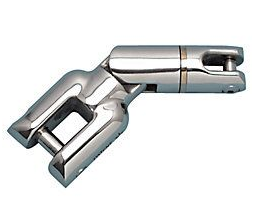
|
If not choosen properly, the swivel may easily become the weakest part of the anchor rode.
Swivels should be used from a reputable brand. The cost of a quality swivel, will be a lot
higher than for a corresponding shackle to obtain euivalent quality and security.
Swivels are sensitive to lateral forces and may easily get stuck under these conditions.
This means they should be installed such that lateral forces cannot be applied across
the joint. One way to do this is not to connect the swivel directly to the shaft of the anchor
but to use a few links of chain between the anchor and the swivel.
Ball-and-joint type swivels try to solve this problem, but they are a compromise as well.
The articulation angle of typically 30 degrees is not adequate. The safe-working-load on these
types is guaranteed only in this operating range, which is considered not realstic.
|
Shackles
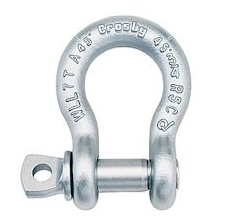 Shackles are the standard method of attaching the anchor to its rode, the section of which
closest the anchor is typically chain.
They offer better value-for-money than their alternative swivel connectors.
But they also tend to be the weakest link in terms of physical strength of the entire anchor tackle,
so maximizing their quality and reliability is of great importance.
Good quality high end shackles are not costly so there is no excuse to compromise on this
element of the system.
High tensile grades of steel of 600 MPa or higher (G6/G8) should be applied for these
components.
Shackles are the standard method of attaching the anchor to its rode, the section of which
closest the anchor is typically chain.
They offer better value-for-money than their alternative swivel connectors.
But they also tend to be the weakest link in terms of physical strength of the entire anchor tackle,
so maximizing their quality and reliability is of great importance.
Good quality high end shackles are not costly so there is no excuse to compromise on this
element of the system.
High tensile grades of steel of 600 MPa or higher (G6/G8) should be applied for these
components.
Shackles are available in numerous different configurations for a wide variety of purposes.
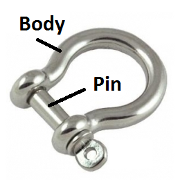
|
The body
The standard configurations are the straight D (or U) shape, and the bow shackle.
The latter is recommended for a single shackle being used with an anchor, as the shape of the
bow can better handle articulating pulls from the rode, although this is not critical.
Working load limits are typically even between the two shapes.
The pin
A regular pin (screw collar pin) can be tightened and undone by hand, although pliers may be
necessary after some time left tightened.
Seizing however is required!
Safety bolt designs require spanners (wrenches) to both tighten and undo, but require no seizing,
and are recommended unless the anchor and rode are to be regularly parted.
|
Thimbles
When the wire rope is terminated with a loop ("eye"), there is a risk that it will bend too tightly,
especially when the loop is connected to a device that spreads the load over a relatively small area.
A thimble can be installed inside the loop to preserve the natural shape of the loop, and protect
the cable from pinching and abrading on the inside of the loop.
The thimble also prevents the load from coming into direct contact with the wire rope.
Rope to chain connections in combination rodes will normally be made utilizing an eye splice and thimble,
which in turn will be attached to the chain portion via an anchor shackle.
Although bulkier than a direct rope to chain splice, this method is simple and reliable.
A proper eye splice should have a minimum of six full tucks and should be seized at each end while
the eye is under tension (to prevent the thimble from falling out should the eye stretch when
placed under load).
 While the open ended "teardrop" shaped galvanized thimble commonly used may be adequate for most situations,
they should not be used in your storm anchor rodes if possible.
Under extreme loading the thimble may work, allowing the sharp edges of the open end to chafe the rode.
A much better choice is an oval thimble or closed ear thimble.
While the open ended "teardrop" shaped galvanized thimble commonly used may be adequate for most situations,
they should not be used in your storm anchor rodes if possible.
Under extreme loading the thimble may work, allowing the sharp edges of the open end to chafe the rode.
A much better choice is an oval thimble or closed ear thimble.
Kellet
Mooring Snubber
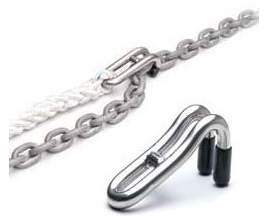 The snubber serves two purposes, to take the load off of the windlass and to provide shock absorption
in conditions requiring it.
The snubber serves two purposes, to take the load off of the windlass and to provide shock absorption
in conditions requiring it.
To take the load off of the windlass, any line and hook combination that will not fail will do the job.
This is a matter of having sufficiently heavy duty components and having good enough shock absorption
to lower the loads.
For shock absorption, the key is to have sufficient stretch in the system.
The factors that effect the elasticity are the line type (braided vs. three strand),
the line material, the line diameter and the line length.
Three-strand nylon has good stretch characteristics and it is relatively cheap.
It can also be easily spiced preventing the need for strength-reducing knots while connecting it to the chain hook.
Smaller diameter lines have greater stretch for a given force as do longer length lines.
The complete setup could be a bridle with two stretch-lines connected to a chain hook.
The hook should be secured against falling off the chain if temporally not under load.
The elasticity of the bridle can be tuned by the length and the strength by taking the two lines in parallel.
The lines should be long enough to allow the snubber to stretch sufficiently to absorb shock loadings
from strong winds or swell.
Stopping shock loadings is essential in difficult conditions if the anchor is to stay well set.
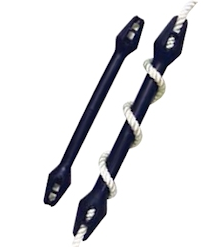
Chain Stopper
Ankarolina
Ankarolina is a special type of anchor rope used for boats.
Ankarolina is sturdy, thick and at the same time lightweight and easy to handle.
The rope is made of polyester, a material that ensures long-lasting ability and thereby less wastage of resources.
When compared to other anchor ropes, ankarolina anchor ropes are easy to coil and unwind because they are flat.
The flatness ensures compactness and easiness for storing the rode on board.
|
Part |
Length
m |
Width
mm |
B/Load
Kg. |
Application |
Yacht
Size
approx. ft |
Reel
Dia.
mm |
Weight
Kg. |
| AK-5625 |
56 |
25 |
2500 |
Anchor line |
up to 40 |
430 |
3.8 |
| AK-5635 |
56 |
35
|
3000 |
Anchor line |
up to 50 |
430 |
5.3 |
| AK-7035 |
70 |
35 |
3000 |
Anchor line |
up to 50 |
490 |
6.5 |
|

 Shackles are the standard method of attaching the anchor to its rode, the section of which
closest the anchor is typically chain.
They offer better value-for-money than their alternative swivel connectors.
But they also tend to be the weakest link in terms of physical strength of the entire anchor tackle,
so maximizing their quality and reliability is of great importance.
Good quality high end shackles are not costly so there is no excuse to compromise on this
element of the system.
High tensile grades of steel of 600 MPa or higher (G6/G8) should be applied for these
components.
Shackles are the standard method of attaching the anchor to its rode, the section of which
closest the anchor is typically chain.
They offer better value-for-money than their alternative swivel connectors.
But they also tend to be the weakest link in terms of physical strength of the entire anchor tackle,
so maximizing their quality and reliability is of great importance.
Good quality high end shackles are not costly so there is no excuse to compromise on this
element of the system.
High tensile grades of steel of 600 MPa or higher (G6/G8) should be applied for these
components.
 While the open ended "teardrop" shaped galvanized thimble commonly used may be adequate for most situations,
they should not be used in your storm anchor rodes if possible.
Under extreme loading the thimble may work, allowing the sharp edges of the open end to chafe the rode.
A much better choice is an oval thimble or closed ear thimble.
While the open ended "teardrop" shaped galvanized thimble commonly used may be adequate for most situations,
they should not be used in your storm anchor rodes if possible.
Under extreme loading the thimble may work, allowing the sharp edges of the open end to chafe the rode.
A much better choice is an oval thimble or closed ear thimble. The snubber serves two purposes, to take the load off of the windlass and to provide shock absorption
in conditions requiring it.
The snubber serves two purposes, to take the load off of the windlass and to provide shock absorption
in conditions requiring it.